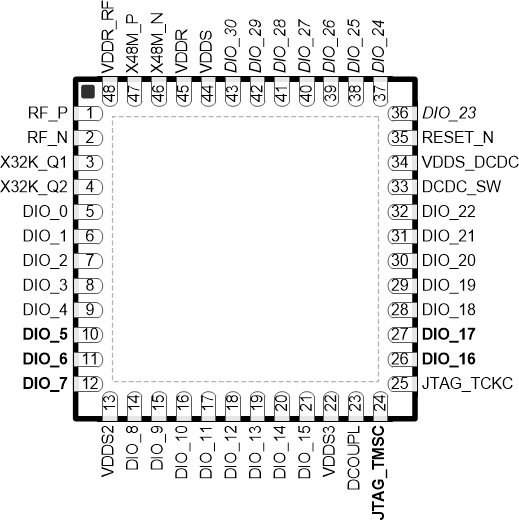JAJSM48B may 2021 – march 2023 CC2652R7
PRODUCTION DATA
- 1 特長
- 2 アプリケーション
- 3 概要
- 4 Revision History
- 5 Device Comparison
- 6 Terminal Configuration and Functions
-
7 Specifications
- 7.1 Absolute Maximum Ratings
- 7.2 ESD Ratings
- 7.3 Recommended Operating Conditions
- 7.4 Power Supply and Modules
- 7.5 Power Consumption - Power Modes
- 7.6 Power Consumption - Radio Modes
- 7.7 Nonvolatile (Flash) Memory Characteristics
- 7.8 Thermal Resistance Characteristics
- 7.9 RF Frequency Bands
- 7.10 Bluetooth Low Energy - Receive (RX)
- 7.11 Bluetooth Low Energy - Transmit (TX)
- 7.12 Zigbee and Thread - IEEE 802.15.4-2006 2.4 GHz (OQPSK DSSS1:8, 250 kbps) - RX
- 7.13 Zigbee and Thread - IEEE 802.15.4-2006 2.4 GHz (OQPSK DSSS1:8, 250 kbps) - TX
- 7.14 Timing and Switching Characteristics
- 7.15 Peripheral Characteristics
- 7.16 Typical Characteristics
- 8 Detailed Description
- 9 Application, Implementation, and Layout
- 10Device and Documentation Support
- 11Mechanical, Packaging, and Orderable Information
6.1 Pin Diagram – RGZ Package (Top View)
 Figure 6-1 RGZ (7-mm × 7-mm) Pinout, 0.5-mm Pitch (Top View)
Figure 6-1 RGZ (7-mm × 7-mm) Pinout, 0.5-mm Pitch (Top View)
The following I/O pins marked in Figure 6-1 in bold have high-drive capabilities:
- Pin 10, DIO_5
- Pin 11, DIO_6
- Pin 12, DIO_7
- Pin 24, JTAG_TMSC
- Pin 26, DIO_16
- Pin 27, DIO_17
The following I/O pins marked in Figure 6-1 in italics have analog capabilities:
- Pin 36, DIO_23
- Pin 37, DIO_24
- Pin 38, DIO_25
- Pin 39, DIO_26
- Pin 40, DIO_27
- Pin 41, DIO_28
- Pin 42, DIO_29
- Pin 43, DIO_30